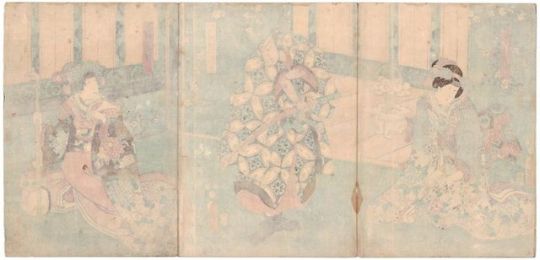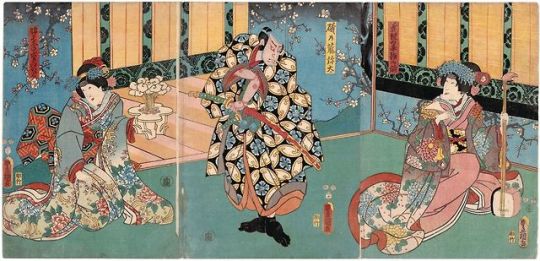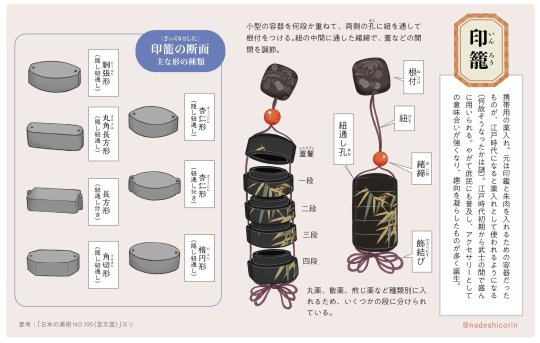#chônin
Note
What patterns are traditionally allowed for a man's kimono? What little I can find indicates that it's stripes or nothing.
In the past, men kimono could be as extragant and luxurious as women's, but men modern kimono fashion takes a lot from Edo era.
The thing is: it was then super regulated by the shogunate which turned a bad eyes at the chônin (=commoners living in cities, especially rich merchants). Those grew richer and richer - much more so than many samurai, and the shogunate dictated sumptuary law after sumptary law to try keep them in check.
In men kimono fashion, this means lavish patterns tended to be hidden: haori linings, juban underwear, etc. It also means they turned to other time consumming techniques to show wealth: edokomon (tiny tiny tiny patterns), and nezumi (grey family) and cha (brown family) subtle colors are some examples.
This historical heritage is sadly still super strong! But that doesn't mean any pattern is actually forbidden :) They are simply used differently, and many men today are pushing the lines so bold patterns (and colors) make a come back!
On a side note, some patterns are much much rarer on women items while they are more easily found on men's: shunga (erotic art), yôkai and/or gruesome sceneries, variation on "manly" symbols like the dragon/tiger imagery, etc etc etc
193 notes
·
View notes
Photo


My New Collection - Ukiyo-e 浮世絵
Ukiyo-e (浮世絵) prints and paintings (see Edo Links below) are among the most widely known and admired arts of the Edo period. Ukiyo-e were the result of a collaboration among artists, block cutters, printers, and publishers; and at its best, there was no finer graphic art ever produced in the woodblock medium anywhere in the world.
The Floating World (ukiyo) was an expression of the new economy and social ambitions of the common townspeople of the Edo period (1615-1868). It was, specifically, a world of play and entertainment in Japan's three main cities (Edo [now called Tokyo], Osaka, and Kyoto). It could also be argued that this "world" was also a state of mind or an ethos, a characteristic spirit of the chônin ("persons of the town").
日语中的“浮世”一词,在古代原为“忧世”,日本人自中世纪以来产生的厌世的人生观是建立在对净土向往的来世期待上的。但随着佛教理念在日本本土的世俗化演变,此岸现实取代了彼岸理想,较之过去或者未来,此时此刻的“现世”享受成为人们追逐的目标,“忧世”也由此被更为轻松明快的“浮世”所取代。
0 notes
Photo

印籠 (inrô) pill box/nested boxes, handy chart by fantastic Edo-lover Nadeshico Rin.
Inrô were first used during Sengoku period by men to carry their personal seals (印鑑 inkan) and thick red ink (朱肉 shuniku). It was then used to carry medecines (薬 kusuri), such as pills (丸薬 ganyaku), powders (散薬 sanyaku), or decoctions (煎じ薬 senjigusuri). Slowy people also added any small trinkets which could fit in.
First carried by samurai class, it then spread to chônin commoners in the Edo period. Many shapes existed, and inrô boxes could be made from many materials depending of their owners’ fortune, from paper to precious ivory. Often beautifully decorated, their designs could include raden (mother of pearl inlays), or makie (gold powder).
On the right, you can see the different part of an inrô:
根付 (netsuke) carved toggle (sometimes very intricated miniature sculptures), slipped into the obi belt
紐 (himo) cord, holding everything together
緒締 (ojime) string-fastener bead, could be made from precious coral or as decorated as netsuke
飾結び (kazari musubi) ornamental knot, at the bottom
紐通し孔 (himodôshiana) lacing hole, to thread the cord into the boxes
蓋鬘 (futakazura) top piece, lid of the box
段 (-dan) row of boxes, ex. 一段 (ichidan) first row
Main types of inrô shapes existed, with of without visible lacing holes (紐通し付き himodôshi tsuki = visible / 隱し紐通し kakushi himodôshi = hidden). Rin details following styles on the left:
杏仁形 (kyônin gata) apricot seed shaped
楕円形 (daen gata) ellipse shaped
胴張形 (dôbari gata) hull shaped
丸角長方形 (marusumi chôhôkei) rounded rectangle shaped
長方形 (chôhôkei) rectangle shaped
角切形 (sumikiri gata) cut-corners shaped
#japan#fashion#fashion history#edo period#references#ressources#nadeshico rin#inro#inrou#pill box#medecine box#kusuri#samurai#raden#mother of pearl inlay#makie#gold powder#netsuke#toggle#chart
399 notes
·
View notes